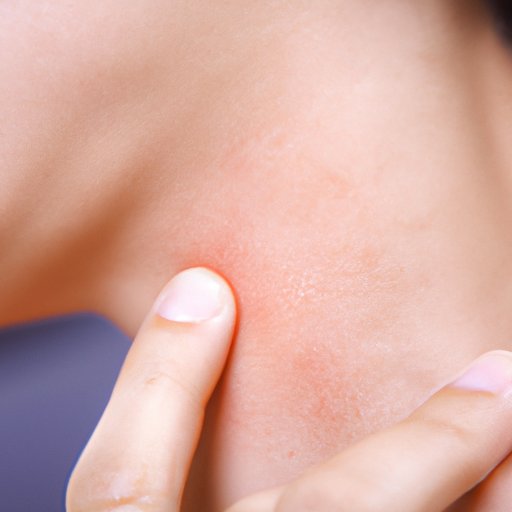
Introduction
Knowing the symptoms of skin cancer is crucial for early detection and better chances of successful treatment. Skin cancer is the most common type of cancer in the United States, and it is estimated that one in five Americans will develop it in their lifetime. This article aims to educate readers on the symptoms of skin cancer, the importance of early detection, and what they can do to protect themselves from skin cancer.
Symptoms of Skin Cancer: Signs to Look Out for and What to Do Next
The most common symptom of skin cancer is a new spot or mole on the skin, or a spot that has changed in size, shape, or color. Other symptoms of skin cancer include the appearance of a sore that doesn’t heal or a spot that becomes itchy, tender, or painful. If you notice any of these symptoms, it is important to see a doctor as soon as possible.
To prevent skin cancer, it is recommended to wear protective clothing, use sunscreen with an SPF of at least 30, and avoid tanning beds.
Early Detection: Understanding Your Risk for Skin Cancer and What to Do About It
Early detection is crucial in effectively treating skin cancer. There are three types of skin cancers: basal cell carcinoma, squamous cell carcinoma, and melanoma. Basal cell carcinoma and squamous cell carcinoma are often caused by sun exposure and tend to develop in areas that are commonly exposed to the sun, such as the face, neck, and arms. Melanoma is the most dangerous type of skin cancer and can develop anywhere on the body, even in areas that are not exposed to the sun.
There are several risk factors for skin cancer, including fair skin, a history of sunburns, a family history of skin cancer, and a weakened immune system. If you have any of these risk factors, it is important to take steps to protect yourself from the sun and to regularly check your skin for any signs of skin cancer.
A Guide to Spotting Skin Cancer: How to Tell If That Spot or Mole is Harmless or Not
Conducting a self-examination is an important part of detecting skin cancer early. When examining your skin, look for spots or moles that are asymmetrical, have irregular borders, are more than one color, are larger than a pencil eraser, or have been changing in size, shape, or color. If you notice any of these changes, it is important to see a doctor as soon as possible.
To track any changes you notice on your skin, take photos of any spots or moles you are concerned about and compare them to new photos every few months.
The ABCDEs of Skin Cancer: What Each Letter Means and How to Use It to Check Your Skin
The ABCDEs of skin cancer stand for asymmetry, border irregularity, color variation, diameter, and evolving. Asymmetry refers to a spot or mole that is not symmetrical in shape. Border irregularity refers to a spot or mole with an uneven or jagged border. Color variation refers to a spot or mole with different shades of color. Diameter refers to a spot or mole larger than 6mm, or about the size of a pencil eraser. Evolving refers to a spot or mole that has been changing in size, shape, or color. If you notice any irregularities with your skin that fit into any of these categories, be sure to seek medical attention.
Skin Cancer Screening: What You Need to Know About Getting Checked and When to Do It
Skin cancer screening is a visual examination of the skin by a dermatologist or other medical professional. The American Academy of Dermatology recommends that everyone gets a skin exam at least once a year, and more often if you have a history of skin cancer or suspicious moles or spots.
If you are concerned about skin cancer or want to get a skin cancer screening, talk to your doctor or dermatologist. They can help you determine if you are at risk and what steps you can take to protect yourself from skin cancer.
Conclusion
Knowing the symptoms of skin cancer, understanding your risk factors, and conducting regular self-examinations and skin cancer screenings are all important steps in protecting yourself from skin cancer. If you notice any concerning changes on your skin, be sure to see a doctor as soon as possible. Remember, early detection is key to treating skin cancer successfully.




